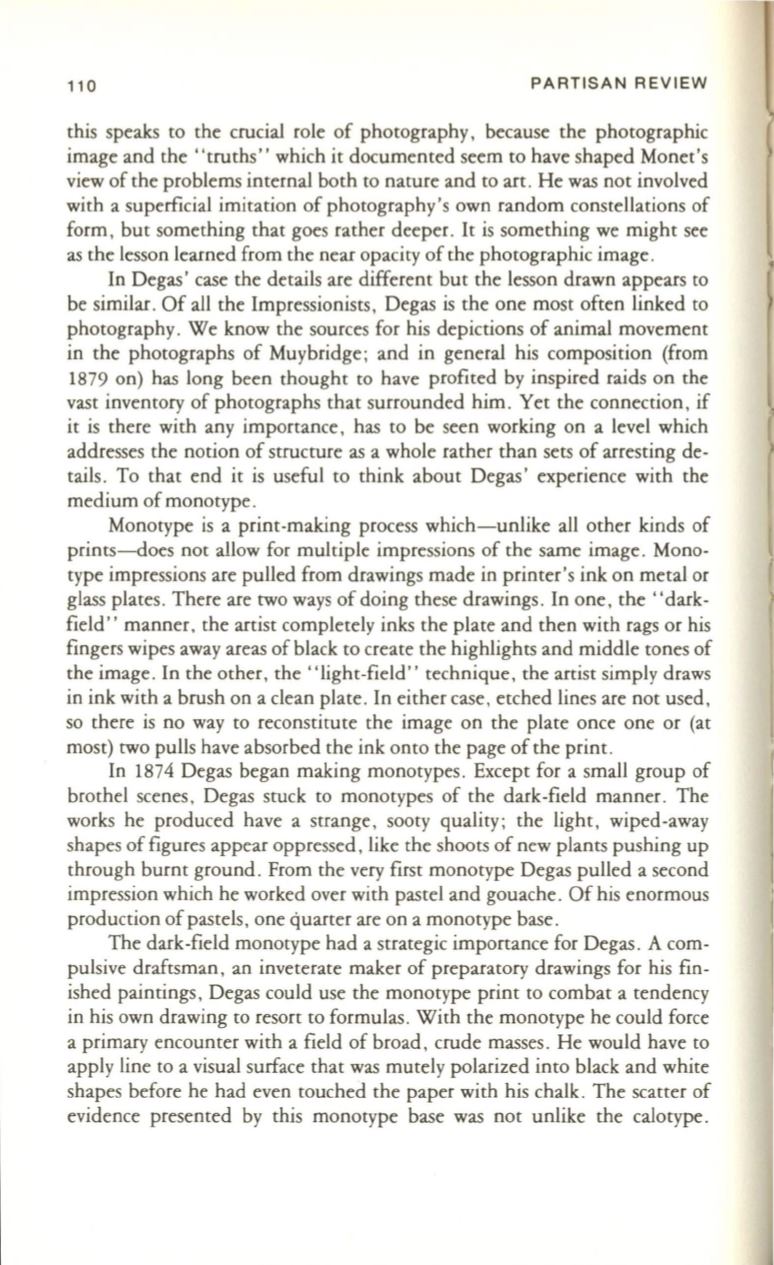
110
PARTISAN REVIEW
this speaks to the crucial role of photography, because the photographic
image and the "truths" which it documented seem to have shaped Monet's
view of the problems internal both to nature and to art. He was not involved
with a superficial imitation of photography's own random constellations of
form, but something that goes rather deeper. It is something we might see
as the lesson learned from the near opacity of the photographic image .
In Degas' case the details are different but the lesson drawn appears to
be similar . Of all the Impressionists, Degas is the one most often linked to
photography. We know the sources for his depictions of animal movement
in the photographs of Muybridge; and in general his composition (from
1879 on) has long been thought to have profited by inspired raids on the
vast inventory of photographs that surrounded him. Yet the connection, if
it is there with any importance, has to be seen working on a level which
addresses the notion of structure as a whole rather than sets of arresting de–
tails. To that end it is useful to think about Degas' experience with the
medium of monotype.
Monotype is a print-making process which-unlike all other kinds of
prints-does not allow for multiple impressions of the same image . Mono–
type impressions are pulled from drawings made in printer's ink on metal or
glass plates . There are two ways of doing these drawings . In one, the "dark–
field " manner, the artist completely inks the plate and then with rags or his
fingers wipes away areas of black to create the highlights and middle tones of
the image . In the other, the "light-field" technique, the artist simply draws
in ink with a brush on a clean plate . In either case, etched lines are not used ,
so there is no way to reconstitute the image on the plate once one or (at
most) two pulls have absorbed the ink onto the page of the print.
In 1874 Degas began making monotypes . Except for a small group of
brothel scenes, Degas stuck to monotypes of the dark-field manner . The
works he produced have a strange, sooty quality ; the light, wiped-away
shapes of figures appear oppressed , like the shoots of new plants pushing up
through burnt ground. From the very first monotype Degas pulled a second
impression which he worked over with pastel and gouache . Of his enormous
production of pastels, one quarter are on a monotype base.
The dark-field monotype had a strategic importance for Degas . A com–
pulsive draftsman, an inveterate maker of preparatory drawings for his fin–
ished paintings, Degas could use the monotype print to combat a tendency
in his own drawing to resort to formulas. With the monotype he could force
a primary encounter with a field of broad , crude masses . He would have to
apply line to a visual surface that was mutely polarized into black and white
shapes before he had even touched the paper with his chalk . The scatter of
evidence presented by this monotype base was not unlike the calotype.


